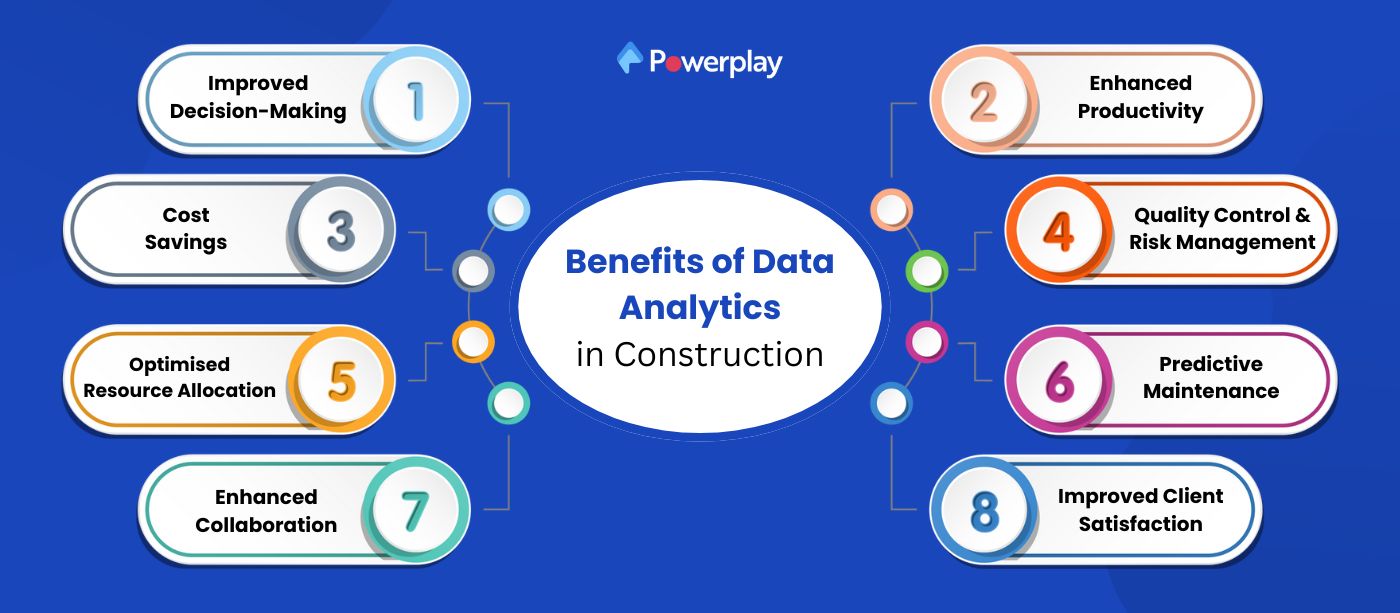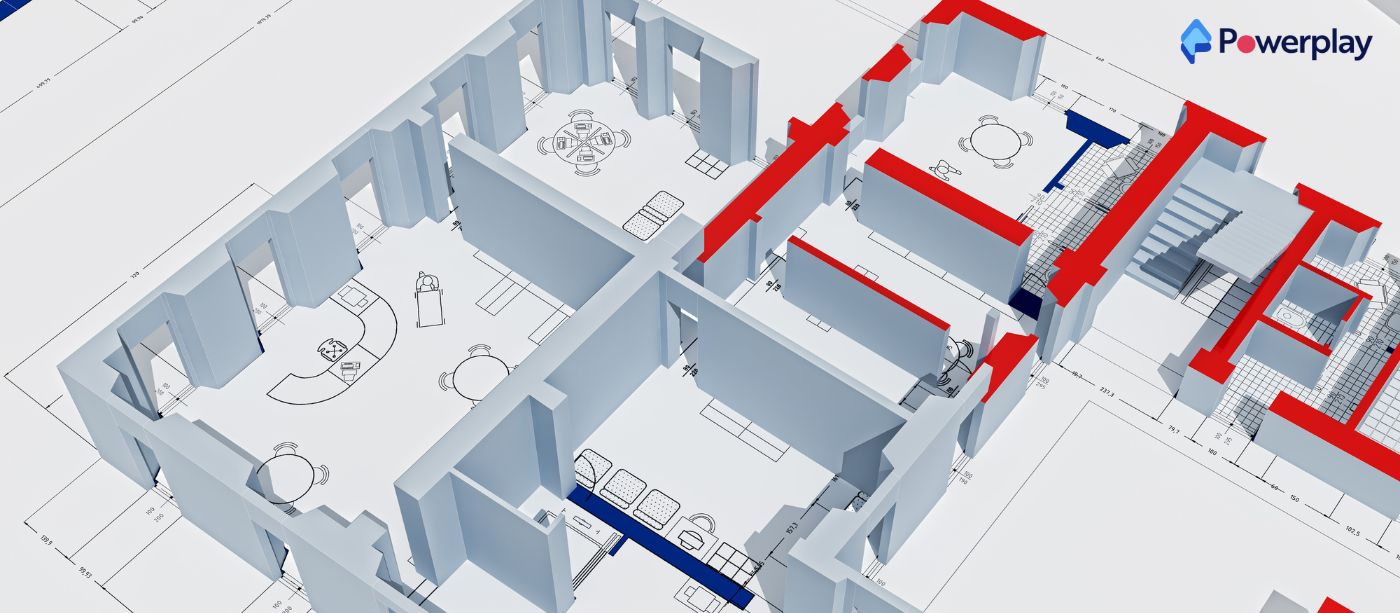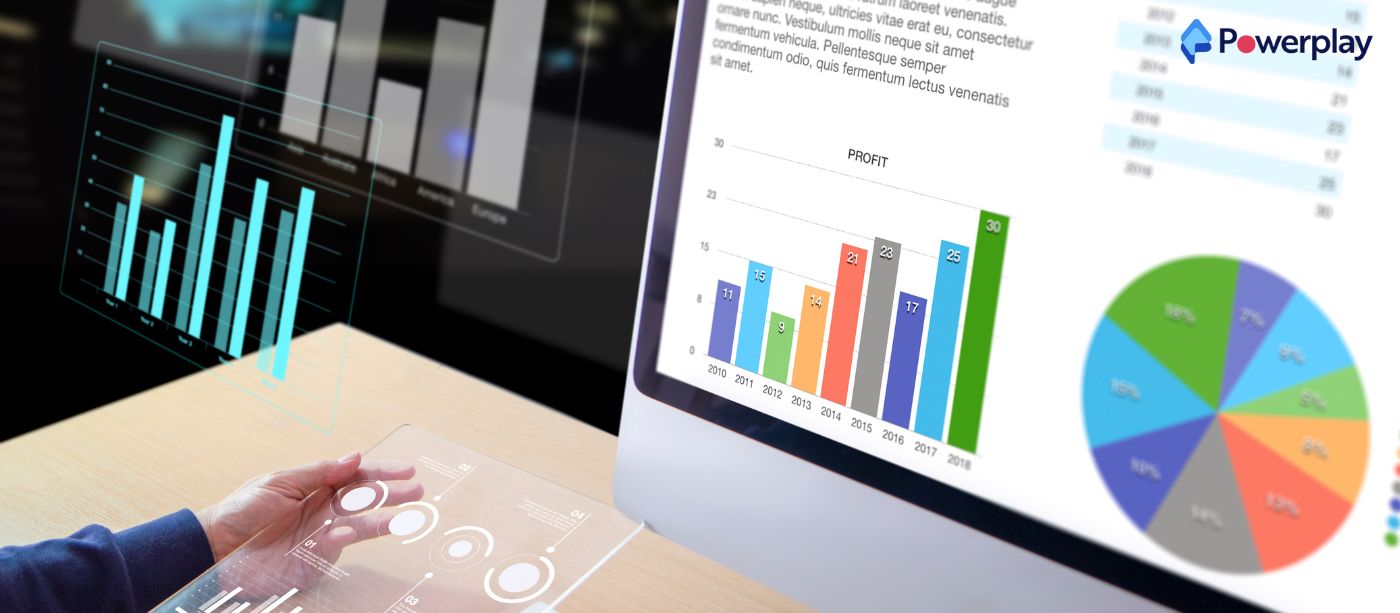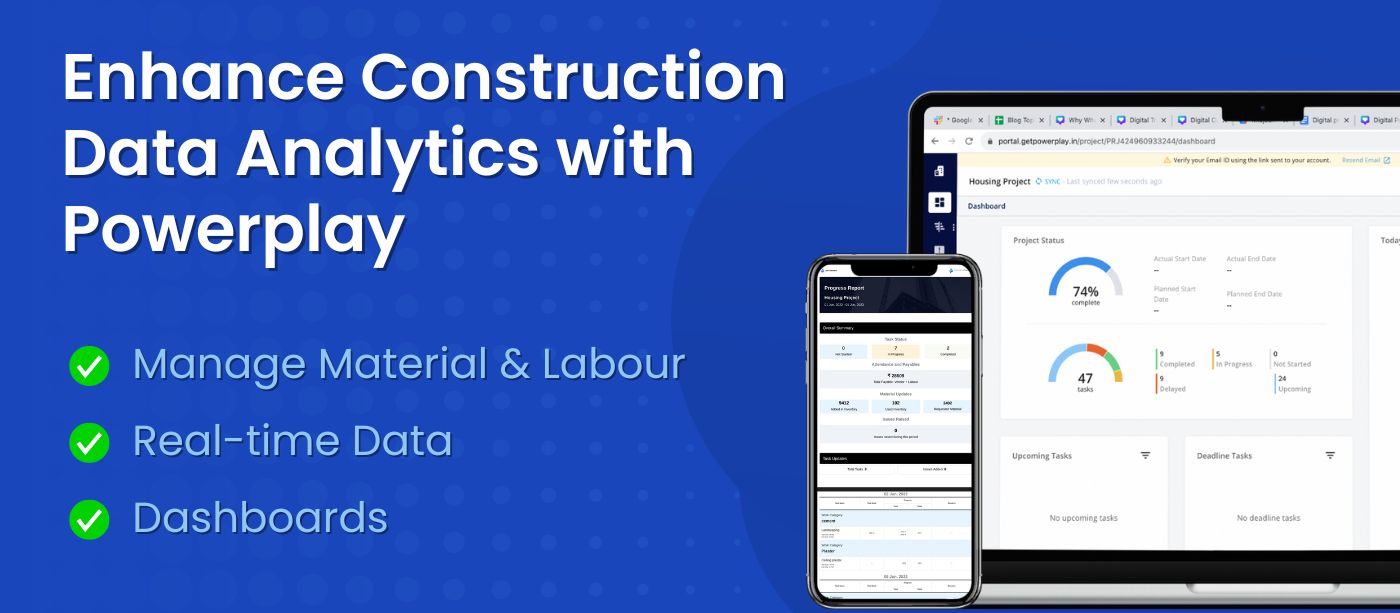11 Examples of Using Data Analytics in Construction
-
Sapna
- May 3, 2024

Table of Contents
Introduction
In the construction industry, efficiency and precision are paramount. However, challenges like cost overruns, delays, and safety concerns often plague projects. Data Analytics has been a game-changer that transforms how we approach construction. By utilising data, construction companies can tackle these challenges head-on, paving the way for smoother operations, better decision-making, and, ultimately, more successful projects.
In this, let’s explore 11 examples of how Data Analytics is revolutionising the construction sector by addressing specific problems and offering innovative solutions.
What is construction data analytics?
Construction data analytics involves collecting, analysing, and interpreting data generated throughout the construction lifecycle, from planning and design to execution and maintenance. It employs various techniques, including statistical analysis, machine learning, and data visualisation, to derive insights and improve decision-making processes within the construction industry.
By harnessing data from sensors, construction project management software, and building information modelling (BIM), construction data analytics enables stakeholders to optimise resource allocation, enhance project efficiency, mitigate risks, and drive innovation in construction projects.
Why Is Data Analytics important in the Construction industry?
Data analytics is crucial in the construction industry. It provides insights that enhance decision-making, efficiency, and project outcomes. It enables stakeholders to optimise resource allocation, identify and mitigate risks, improve project scheduling and budgeting, and enhance overall project management.
By analysing data from various sources such as sensors, BIM models, and project management software, construction professionals can identify patterns, trends, and areas for improvement. This leads to more informed decision-making, cost savings, reduced errors, increased productivity, and, ultimately, the delivery of higher quality projects on time and within budget, thereby improving competitiveness and customer satisfaction in the construction industry.
The Rise of Data in Construction
The increasing availability and importance of digital technologies drive the rise of data in construction projects. These technologies, including Building Information Modeling (BIM), Internet of Things (IoT) sensors, and project management software, generate vast amounts of data throughout the construction lifecycle.
This data provides valuable insights into project performance, resource utilisation, and risk management. Furthermore, advancements in data analytics enable stakeholders to extract actionable intelligence from this data, leading to improved decision-making, enhanced productivity, and better project outcomes. As construction projects become more complicated and stakeholders demand greater efficiency and transparency, the importance of data in construction continues to grow.
Benefits of Data Analytics in Construction

- Improved Decision-Making: Data analytics provides stakeholders with valuable insights into project performance, enabling them to make informed decisions promptly, leading to more efficient resource allocation and risk mitigation.
- Enhanced Productivity: By analysing data on project timelines, resource usage, and workflow patterns, construction teams can identify bottlenecks and inefficiencies, allowing them to streamline processes and optimise productivity.
- Cost Savings: Data analytics helps identify cost-saving opportunities by identifying areas of waste, optimising resource allocation, and improving budget forecasting accuracy, ultimately leading to reduced project costs.
- Quality Control and Risk Management: Through data analysis, construction teams can monitor quality standards more effectively and identify potential risks, such as safety hazards or delays, allowing for proactive measures to mitigate these risks.
- Optimised Resource Allocation: By analysing data on material usage, equipment utilisation, and labour productivity, construction companies can allocate resources better, reducing idle time and optimising project schedules.
- Predictive Maintenance: Data analytics can help predict equipment failures and maintenance needs by analysing data from IoT sensors and equipment monitoring systems, enabling proactive maintenance to prevent costly downtime.
- Enhanced Collaboration: Data analytics facilitates better communication and collaboration among project stakeholders by providing a centralised platform for sharing and analysing project data, leading to improved coordination and alignment of project objectives.
- Improved Client Satisfaction: By leveraging data analytics to track project progress, manage timelines, and ensure quality standards, construction companies can enhance client satisfaction by delivering projects on time, within budget, and to the expected quality standards.
11 Examples of Using Data Analytics in Construction
Data analytics in construction streamline various aspects of construction projects and enhance operational efficiency and customer satisfaction, ultimately leading to more successful project outcomes. Here are 11 examples of how data analytics can be applied in the construction industry:
Project Planning and Modeling:

Data analytics help create more accurate models and simulations during the planning phase. By analysing past project data, planners can more effectively predict timelines, budget requirements, and potential challenges. This helps optimise resources and schedules, reducing the likelihood of delays and cost overruns. Advanced tools like Building Information Modeling (BIM) integrate data analytics to provide a comprehensive visual and numerical model of the project.
Predictive Analytics:
Predictive analytics includes using historical data to predict future outcomes in a construction project. It can identify potential project delays, equipment failures, or budget issues before they occur. By applying machine learning algorithms, construction managers can preemptively address these risks, enhancing overall project efficiency and reliability.
Warranty and Risk Analysis:
Data analytics aids in analysing product warranties and assessing risk factors associated with construction materials and methods. This can lead to better decision-making about material choices and construction techniques, minimising future liability and repair costs. Analytics can also pinpoint trends in equipment malfunctions or structural failures, helping firms adapt their practices to mitigate similar risks.
Accurate Budgeting:
Analytics allows for more precise budget forecasts by analysing historical project costs and outcomes data. This reduces the financial risks associated with cost overruns and ensures that projects are adequately funded, with contingencies accurately reflected.
Subcontractor Performance Analytics:
Evaluating subcontractor performance through data analytics involves tracking quality, timeliness, and compliance with safety standards. This analysis helps select the right subcontractors for future projects and manage ongoing contracts more effectively.
Construction Site Optimisation:

Analytics can optimise a construction site’s layout and operations. By analysing movement patterns and logistics data, managers can design site layouts that reduce travel time for materials and workers, streamline operations, and enhance productivity.
Safety Management:

Data analytics is crucial to improve safety standards on construction sites. By analysing accident reports and near-misses, predictive models can identify potentially hazardous practices and conditions. This allows managers to implement preventive measures, reducing the incidence of accidents.
Sustainability Analysis:
Analytics can assess construction projects’ environmental impact, helping firms make data-driven decisions that align with sustainability goals. This includes optimising material usage, reducing waste, and selecting environmentally friendly materials and methods.
Customer Satisfaction Analysis:
Data analytics helps construction companies improve their service delivery by analysing client feedback. Insights gained from customer satisfaction surveys can guide project adjustments and enhance client relations, leading to better retention rates and more referrals.
Facility Management and Maintenance:

Data analytics helps predict when building components will need maintenance or replacement. This proactive approach to facility management ensures that maintenance is timely and disruptions are minimised, extending the facility’s lifespan while optimising maintenance budgets.
Construction Workforce Analytics:
This involves analysing workforce data to improve hiring practices, optimise team compositions, and enhance productivity. Analytics can identify the skills most effective for certain jobs and predict workforce needs based on project pipeline, improving manpower allocation.
Getting Started with Data Analytics in Construction
Getting started with data analytics in construction involves evaluating existing data capabilities and creating a strategy focused on improving efficiency and decision-making. Implementing this involves various challenges and considerations, such as:
Challenges and Considerations:
When integrating data analytics into construction, several challenges and considerations emerge. One primary challenge is collecting and standardising data across different sources, such as supply chain, workforce, and project management systems, which may be incompatible. Additionally, the construction industry often grapples with resistance to change, particularly from teams accustomed to traditional methods. There’s also the significant consideration of investing in the right technology and training personnel to use analytics tools effectively.
Actionable Steps:
To overcome all challenges, you need to follow these a series of actionable steps:
- Assess Current Capabilities: Begin by evaluating the existing data infrastructure and the analytical skills of the workforce. Understanding where your organisation stands will help identify the gaps and needs for successful analytics implementation.
- Develop a Strategy: Create a clear, focused strategy for data analytics tailored to specific goals, such as improving project delivery times, enhancing safety, or increasing profitability. This strategy should include specific milestones and measurable objectives.
- Invest in Technology and Training: Invest in the necessary analytics tools that suit your specific needs and ensure they integrate well with your current systems. Equally important is investing in training for your team members to ensure they can use these tools effectively.
- Start Small: Pilot analytics in smaller projects to manage risk and learn from mistakes. This controlled environment allows adjustments and scaling strategies based on successes and challenges.
- Scale Gradually: Based on the insights and successes from pilot projects, gradually expand the use of data analytics across more projects and departments. Continuous improvement should be a key aim as you scale up, with adjustments made as more data becomes available and more insights are gained.
- Foster a Data-Driven Culture: Encourage a shift in company culture that embraces data-driven decision-making. This involves regular training, sharing success stories, and visibly supporting data-driven initiatives from the top down.
How Powerplay Helps in Construction Data Analytics
Powerplay helps construction owners and managers significantly enhance construction data analytics by offering comprehensive features across various key areas. It offers material management features that help users track inventory levels and usage patterns in real-time, helping to prevent overstocking and shortages. With its labour management features, users can have detailed insights into labour productivity and workforce allocation, ensuring optimal use of human resources.
Additionally, with Powerplay, users can also have a clear picture of their detailed project status updates, enabling managers to monitor progress in real time, find potential delays, and make data-driven decisions to make sure projects are kept on track and within budget.
Conclusion
In construction, Data Analytics isn’t just a tool; it’s a game-changer. Picture a future where every project isn’t just about building and pushing the boundaries of innovation and accuracy. From keeping an eye on progress in real-time to foreseeing potential issues through predictive models, Data Analytics revolutionises how we build. It’s not just about using resources efficiently or managing risks; it’s about crafting a whole new approach to construction. Tomorrow’s construction industry won’t just erect structures; it’ll pioneer a new era of data-driven precision, where outcomes are anticipated, dangers are averted, and every step is guided by intelligence and data.

















